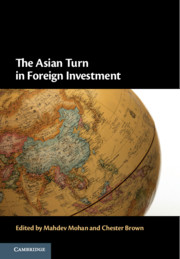Book contents
- The Asian Turn in Foreign Investment
- The Asian Turn in Foreign Investment
- Copyright page
- Contents
- Figures
- Tables
- Contributors
- Acknowledgements
- Table of Cases
- Table of Treaties
- Abbreviations
- Part I Introduction
- Part II National Approaches within Asia to the Regulation and Protection of Foreign Investment
- 2 Investment Agreements and Dispute Settlement in Singapore
- 3 Pharmaceutical Patents and Expropriation in Indian Bilateral Investment Treaties
- 4 Out with the Old, In with the New?
- 5 China and the Investment Treaty Regime
- 6 Procedural Models to Upgrade BITs
- Part III The Rebalancing of Regulatory Space and Investor Protection in Asia
- Part IV Multilateral Rule-Making in Asia on Trade and Investment: From ASEAN to the Comprehensive and Progressive Agreement for Trans-Pacific Partnership
- Part V Emerging Issues
- Part VI What Lies Ahead?
- Index
6 - Procedural Models to Upgrade BITs
China’s Experience
from Part II - National Approaches within Asia to the Regulation and Protection of Foreign Investment
Published online by Cambridge University Press: 13 August 2021
- The Asian Turn in Foreign Investment
- The Asian Turn in Foreign Investment
- Copyright page
- Contents
- Figures
- Tables
- Contributors
- Acknowledgements
- Table of Cases
- Table of Treaties
- Abbreviations
- Part I Introduction
- Part II National Approaches within Asia to the Regulation and Protection of Foreign Investment
- 2 Investment Agreements and Dispute Settlement in Singapore
- 3 Pharmaceutical Patents and Expropriation in Indian Bilateral Investment Treaties
- 4 Out with the Old, In with the New?
- 5 China and the Investment Treaty Regime
- 6 Procedural Models to Upgrade BITs
- Part III The Rebalancing of Regulatory Space and Investor Protection in Asia
- Part IV Multilateral Rule-Making in Asia on Trade and Investment: From ASEAN to the Comprehensive and Progressive Agreement for Trans-Pacific Partnership
- Part V Emerging Issues
- Part VI What Lies Ahead?
- Index
Summary
With the rise of a new generation of investment policies, the modernisation or upgrading of existing bilateral investment treaties ('BITs') is of significant interest to States. China has upgraded 28% of its investment treaties in various ways. Two investment arbitration tribunals and one highest court at the seat of arbitration have recently rendered decisions favouring the application of old Chinese BITs over the upgraded ones. China’s experience with upgrading BITs may provide general policy discourse and direction for other countries planning to upgrade their BITs. Using China’s experience, this paper categorises a typology of upgrading BITs into the Co-existence Model (parties to an old BIT join existing or new FTAs or a regional investment agreement), the Replacement Model (replace an old BIT with a new one), the Amendment Model (amend an old BIT by a protocol) and the Joint Interpretation Model (issue a diplomatic announcement to interpret a BIT). This paper also discusses the benefits and challenges of each Model and concludes with possible directions for future BIT upgrading.
Keywords
Information
- Type
- Chapter
- Information
- The Asian Turn in Foreign Investment , pp. 80 - 100Publisher: Cambridge University PressPrint publication year: 2021
